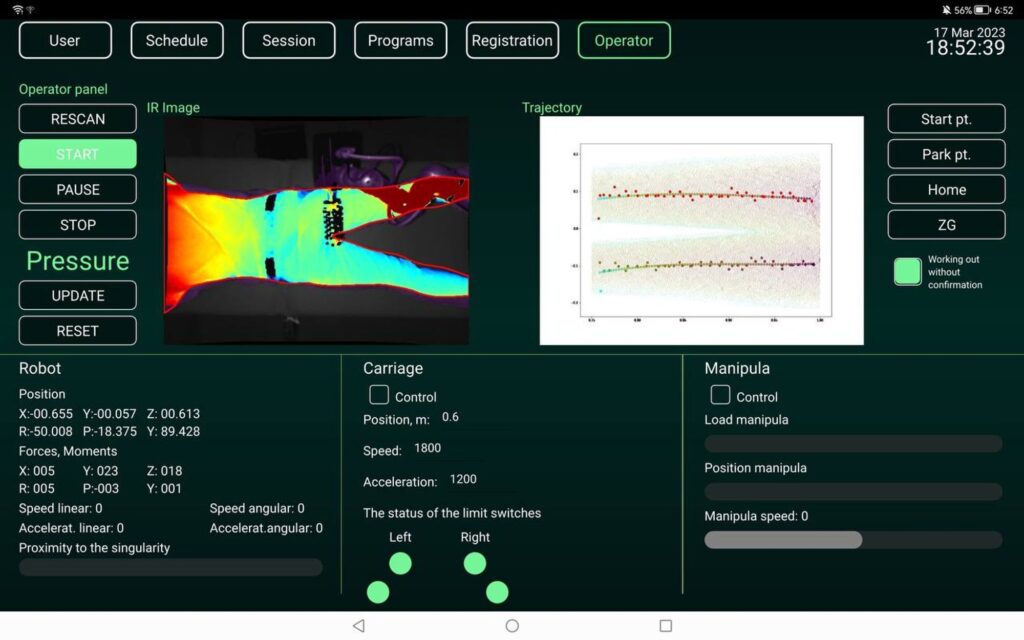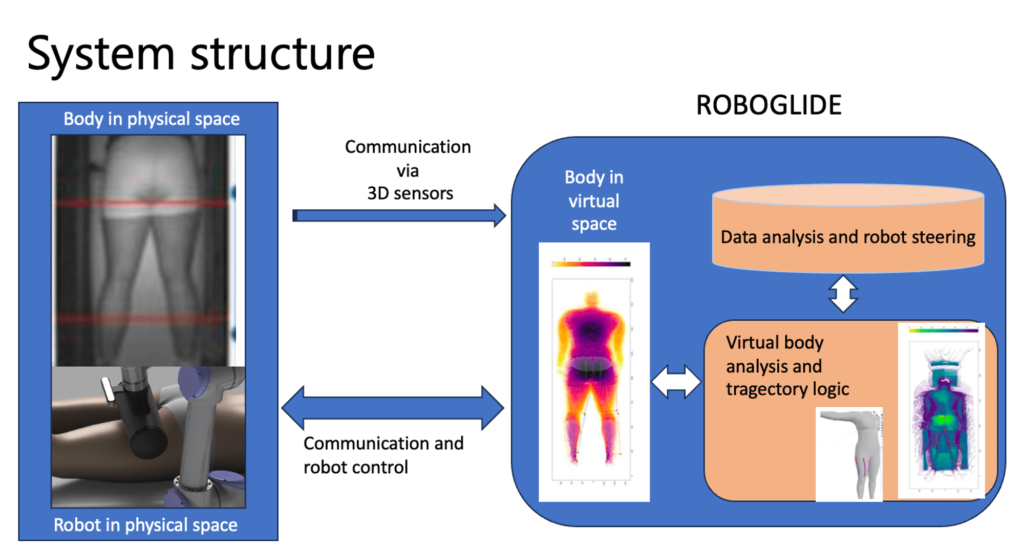Roboglide: Real-Time Body Detection for Robotic Treatments in Healthcare

Abstract
The Robosculptor is highly versatile and can be used for a wide range of non-invasive body treatments that require real-time positioning of the human body. This includes treatments such as medical massage, laser hair removal, and skin rejuvenation, among others. The Robosculptor can accommodate a variety of tools that can be easily attached to the system to suit specific treatment needs.
One of the unique features of the Robosculptor is its real-time control of body positioning and applicator adjustment. During a session, patients may inevitably move, which is why our system continuously monitors and adjusts its trajectory and movement.
This is made possible through our innovative 3D dynamic control of body positioning in real time. First, the system requires estimated dimensions of the patient’s body, such as weight and length. Then, a high-speed 3D camera scans the body in just 10 seconds, creating a unique 3D model. Even if the patient moves, the system immediately builds a new trajectory and map of the tool’s movement.
Introduction
The integration of robotics and artificial intelligence in healthcare has paved the way for innovative solutions in patient care. RoboGlide, an innovative technology, is poised to revolutionize various medical disciplines by offering automated body-surface treatments while minimizing the need for extensive human intervention. Beyond its ability to provide highly precise treatments, RoboGlide has the potential to streamline technology adoption and mitigate workforce shortages in critical healthcare areas such as physiotherapy, aesthetics, ultrasonic diagnostics, radiology, and more
Vision: Automation of Treatments and Diagnostics
RoboGlide’s fundamental vision centers around the concept that the fusion of robotics, machine learning, and artificial intelligence will implement process of human-robot interaction (pHRI) or even fully automated treatments and diagnostics.
- Workforce Shortage Mitigation: By automating routine and repetitive tasks, RoboGlide alleviates the strain on healthcare professionals, allowing them to focus on more complex and specialized aspects of patient care.
System Structure
The RoboGlide system is structured around the following key components and processes:
1) Data Collection from a Patient’s Body with 3D Sensors
RoboGlide initiates the treatment process by collecting precise 3D data from the patient’s body, achieved through the use of 3D sensors (ToF cameras). 3D ToF technology provides a complete scene depth map through one-time imaging, without scanning devices. ToF depth cameras with suitable technical characteristics are commercially available and cost-effective on the market. We use up to 4 3D ToF cameras to collect point cloud of a whole human body at 30 frames per second rate. Each 3D ToF camera provide us 640 x 480 resolution frames with less then 7 mm distance error.
2) Building the Point Cloud
The collected data is processed to create a cloud of points that accurately represents the patient’s body surface. This point cloud forms the basis for subsequent steps in the treatment process.
3) Data Collection by entering a Patient’s Body parameters
Inputting data about Patient’s body characteristics into the system, such as length, width, weight of a patient.
4) Creating a Virtual 3D Body Model
A virtual 3D body model is generated, serving as a digital twin of the patient’s body. This model forms the basis for planning and executing robotic steering for automated treatments
5) Aligning the Cloud of Dots with the Virtual 3D Model
The cloud of dots is aligned with the virtual 3D body model, ensuring that the digital representation accurately reflects the patient’s body shape and position. The point cloud serves as the master, and the virtual model becomes the slave, adjusting to match the real-time data.
6) Aligning the Trajectory of Medical Tool Movement onto the Virtual 3D Model
The system meticulously aligns the trajectory of the medical instrument’s movement with the virtual 3D model, guaranteeing precision in instrument placement according to a route map, defined in a treatment protocol.
7) Real-time Control of a Robotic Arm
RoboGlide features a robotic arm equipped with the medical instrument, which is controlled in real-time. The system continuously updates the arm’s position and orientation based on the patient’s body data, ensuring optimal instrument placement.
8) Operation of Robotic Arm
The robotic arm, with the medical instrument attached, operates seamlessly to carry out the prescribed treatment.
9) Constant Plan/Fact Control of Following the Trajectory of the Treatment
Throughout the treatment procedure, RoboGlide provides constant monitoring and control to ensure that the robotic arm adheres to the planned trajectory. Any deviations are corrected in near-to real-time 0,1-0,2 sec, guaranteeing the accuracy of the treatment. The precision of the robotic arm ensures that treatments are consistently accurate. The delay in patients body position recognition process is from 5 to 10 fps and current lowest precision is about 10 mm. At a stable body position precision increases up to 0,5 mm.

Software in the Core
- Real time body detection in 3D and HQ (10 fps, precision +-1mm)
- Treatment protocols environment
- Integreted ML+AI system for increased system of body position
- Operator’s Interface
- Patients interface (for right pose taking)
Applications
RoboGlide has a wide range of applications across the healthcare spectrum:
- Physiotherapy: Automated physiotherapy sessions for targeted muscle therapy.
- Aesthetics: Precise and consistent aesthetic treatments.
- Ultrasonic Diagnostics: High-precision ultrasonic body surface scanning for medical diagnostics.
- Radiology: Distance-operated radiological procedures.
- And More: RoboGlide’s adaptability extends its potential into numerous medical domains.

Interfaces
The RoboGlide system offers two interfaces:
- Operator’s Interface: Healthcare professionals can use this interface to plan treatments, enter non-private patients body parameters, select a treatment, monitor progress, and make real-time adjustments.
- Patient’s visual Interface: Patients can interact with this interface to ensure proper positioning during treatments and see treatment related information.
- Patient joystick interface: Enables to control parameters of a treatment within certain level, if applicable.
- Safety interface: For Safety reasons there are 3 red buttons installed – one in the reach of a therapist, one in reach of a patient. Additional safety button on the patient’s joystick interface.
Conclusion
RoboGlide represents step in the automation of body treatment procedures. By combining real-time body detection, robotic precision, machine learning and artificial intelligence, this technology offers the potential to revolutionize physiotherapy, medical massage, rehabilitation, and medical diagnostics.
Market use
As we move toward automation in healthcare, RoboGlide can be implemented by manufacturers of robots or cobots. to deliver a ready-to-use tech-solution. Manufacturers of medical devices may have a ready-to-implement application kits to use in their products.
Currently the system is being implemented in Robosculptor – a robotic complex for various body therapy manipulations, like aesthetic massage, lymphatic drainage, wellness massage.
